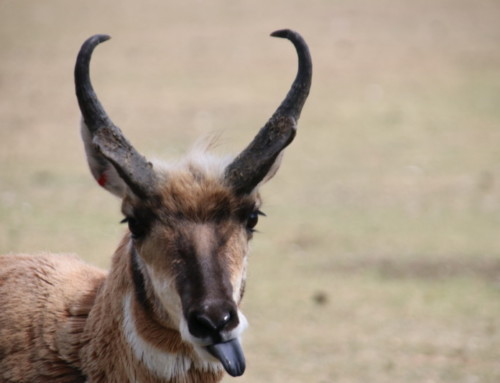Swift Fox – Vulpes velox
Floating along at speeds nearing 40 k/hr when necessary, the little buff-coloured animal appeared to be just a part of the waving, tawny grasses of the high plains of North America. The Swift Fox, Vulpes velox, was once found on the arid short-grass plains and shrubby deserts from southern Canada to New Mexico. At 1.6 to 2.5 kg and averaging 84 cm in length, they are among the smallest members of the Canidae, or dog family. They have large triangular ears, buffy yellow fur, with black spots on the sides of the muzzle and a black tip on the end of the bushy tail. The underparts and inside of the ears are creamy white.
The Swift Fox almost disappeared over most of its range during the first half of the 20th century. They would often take poisoned bait intended for other animals. The almost total conversion of the prairies to cropland destroyed most of the fox’s habitat. They were classed as extirpated (wiped out in Canada) in Canada in 1978. Since then, various breeding programs have been set up to produce animals for reintroduction to the wild. Some of these efforts have been fairly successful in southern Alberta and Saskatchewan. However, captive-bred animals do not, yet, have the wariness or defensive behaviours to protect them from coyotes or other predators such as golden eagles or the occasional wolf. There has been a high mortality rate among the reintroduced foxes. They are now protected in some U. S. states as an endangered species.
Swift Foxes are solitary animals except during the breeding season. They breed from December to February. After a gestation period of 50 days, 2 to 7 pups are born. Both parents care for the young. When the pups emerge from the den at 3 weeks of age, the parents teach them to hunt. There is a strong family bond. If the vixen (female) dies, the dog (male) will raise the pups alone. The young stay with the parents until fall, when they disperse to find their own territories. Swift Foxes are nocturnal hunters. Their main prey species are rabbits, ground squirrels, mice, rats, and occasionally birds, insects, lizards and vegetation. They spend the daylight hours asleep in burrows that they have either dug themselves or that have been abandoned by badgers, woodchucks, or prairie dogs.
As members of the Canidae, they have many characteristics in common with other “dogs”. They walk and run on the four toes of each foot. Their feet are well adapted to travel and they rely on animals they can run down and catch; although their usual behaviour is stalk and pounce. A Swift Fox may have a territory of 2.5 square kilometers. Pair are usually monogamous and a pair may mate for life. They mark their territories with urine and feces, providing an “olfactory fence”. Foxes vocalize with shrill yaps, but also make a variety of other noises. They may live 10 – 12 years in captivity but only 3 – 6 years in the wild. We have a pair of these lovely animals at the Saskatoon Zoo. They are often visible since the zookeepers have been locking them out of their den during the day.
ALL ABOUT THE SURGERY: The Saskatoon Forestry Farm Park and Zoo is lucky to be so close to the University of Saskatchewan’s Veterinary College. The vets come out once a week (more if we need) to check on the condition of the animals at the Zoo. Sometimes, the animals need more than just a check-up. The zookeepers noticed that one of our Swift foxes was unable to bear weight on one of his legs. Concerned, they turned to the vets for advice. It was discovered that his knee had a cranial cruciate ligament rupture (ouch) and a medial meniscus tear. If you were to have that as a person, you would be talking about an ACL (anterior cruciate ligament) and a meniscus injury. In easy terms, the ACL stabilizes the leg and the meniscus provides the cushioning and helps with positioning the knee. With an injury to both of these areas, the fox found it very difficult to put weight on his leg. Luckily, the vets fixed him up and he has now returned to his home at the Forestry Farm. Occasionally, you may still see him with a slight limp while his leg is healing. The vets and the zookeepers are keeping a close eye on him as he heals.

